
On Saturday, September 18, 2021, "Van Gogh Exhibition: Resonating Souls Helene and Fincent" opened at the Tokyo Metropolitan Art Museum in Ueno, Tokyo. The session is until December 12th (Sun).
An exhibition that highlights the collection of Helene Kröller-Muller (1869-1939), the largest individual collector of Van Gogh's works. We will report on the venue where popular works such as "Country Road in Provence at Night" and "Yellow House (Street)" are lined up.
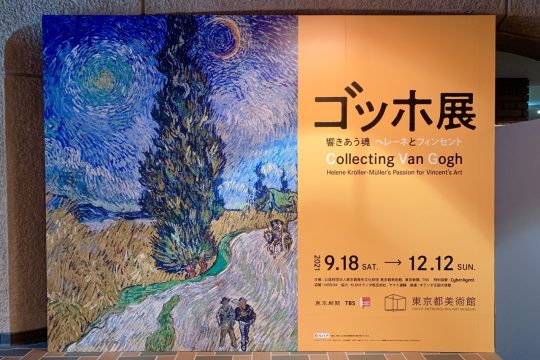
Entrance poster
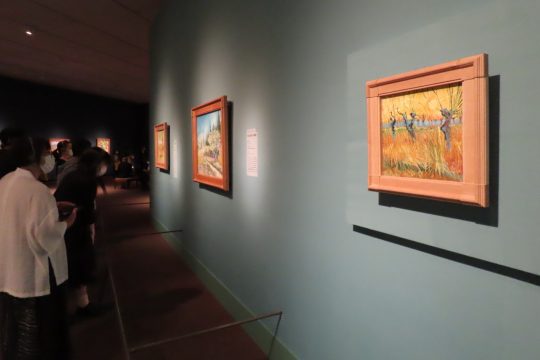
Exhibition scenery

Exhibition scenery
Van Gogh's popular driving force Helene Kröller-Muller
Vincent van Gogh (1853-1890), who has fans all over the world and is one of the most beloved painters here in Japan.
It is said that he aspired to be a painter at the age of 27 and left about 2,000 works in the 10 years until his life ended at the age of 37. In my lifetime, I couldn't get fame.
However, he is now positioned as a master of modern art, and his works can be priced in the hundreds of millions or billions. Behind this was the passion of those who recognized the value of his work, preserved it, and worked hard to preserve it for posterity.
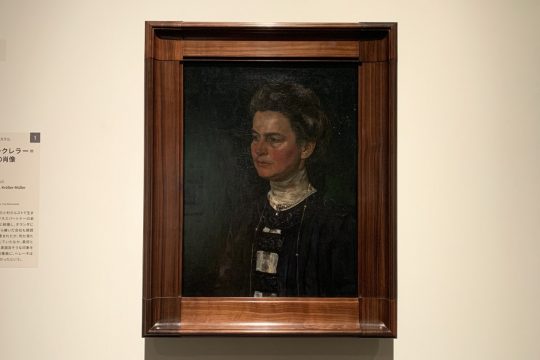
Floris Ferstel "Portrait of Helene Kröller-Muller" 1910 Kroller-Muller Museum Collection
One of the key players who played an important role was Helene Kröller-Muller, who was spotlighted in this "Van Gogh Exhibition: Resonating Souls Helene and Fincent".
Helene, one of the leading Dutch wealthy men, has built a huge collection of over 11,000 pieces with her husband Anton, focusing on the works of French and Dutch artists from the 19th to 20th centuries. She felt deep humanity and spirituality in Van Gogh's work, and collected more than 90 oil paintings and about 180 drawings and prints from the beginning of the 20th century, when Van Gogh was not yet widely evaluated.
This exhibition introduces 48 selected works from Van Gogh's early to late years' paintings from the precious art collection of the Kroller-Muller Museum in the Netherlands (opened in 1938), where Helene was the first director. is.

Vincent van Gogh "Lemon Basket and Bottle" May 1888 Collection of the Kroller-Muller Museum Some works introduce related episodes of the work and Helene.

Vincent van Gogh "Outside the Forest" August-September 1883 A memorable Van Gogh work first purchased by Helene from the Kroller-Muller Museum.
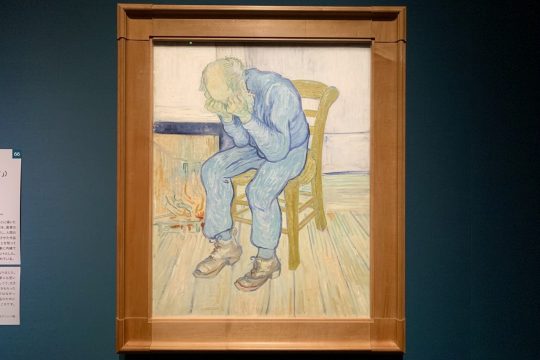
Vincent van Gogh "At Eternity's Old Man (" At Eternity's Gate ")" May 1890 Kroller-Muller Museum Collection A work based on a self-made print made in the past. Helene praised this painting as a work that sublimated human suffering to the point of comfort.
Helene relied on Van Gogh, but Helene himself did not leave a clear word as to why she was so attracted. Mr. Ohashi, the curator in charge of this exhibition, said, "I can't say for sure, but I felt a very high spirituality in Van Gogh's art. Also, Van Gogh, who was born as the son of a pastor, frustrated his path to becoming a priest. That's what he did, and Helene was also suffering because she wasn't familiar with Christian culture. That common background may be a major reason. "
In addition to Van Gogh's works, 20 modern Western paintings from the mid-19th century to the 1920s, such as Millet, Renoir, Surah, and Mondrian, which Helene collected particularly enthusiastically, are also exhibited in this exhibition. ..

Pierre-Auguste Renoir "At the Cafe" circa 1877 Kroller-Muller Museum Collection
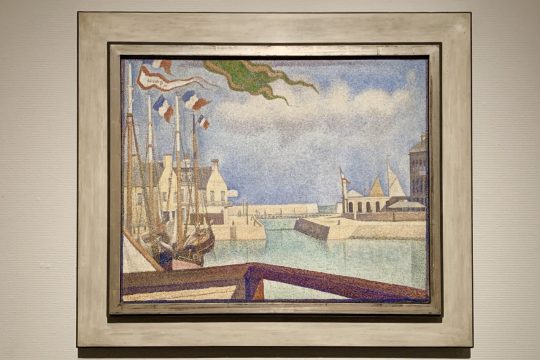
Georges Seurat "Sunday of Paul-en-Bessin" 1888 Kroller-Muller Museum Collection

Odilon Redon "The Cyclops" circa 1914 Kroller-Muller Museum Collection
From realism to impressionism, neo-impressionism, symbolism, and abstractionism. Not only does Van Gogh's work follow the flow of modern painting, which has changed 180 degrees from the realism that depicts it as it is to the focus on the human spirit and emotions, but Van Gogh's work is a bridge between the changes. It is an exhibition that you can see in.
From these Helene collections, in order to share the excitement she got with people, she systematically built a collection so that she could overlook the outline of Western art, with her lifelong mission to establish a museum from the early stages of collection activities. You can see that.
Visited Japan for the first time in 16 years! Masterpiece of the Itosugi series "Country road in Provence at night"
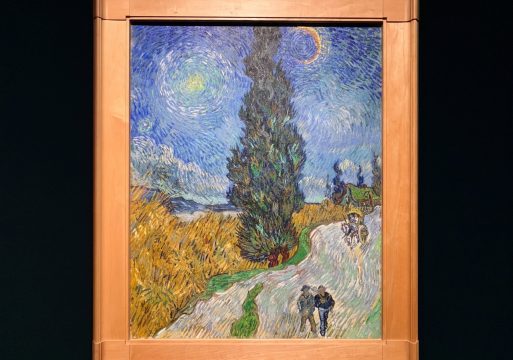
Vincent van Gogh 《Country Road in Provence at Night》 May 12-15, 1890 Kroller-Muller Museum Collection
One of the highlights of this exhibition is "Country Road in Provence at Night", which is the first time in 16 years to visit Japan.
Van Gogh's masterpiece is a series of sunflowers, but for Van Gogh, who was fascinated by the dark green color and beauty of the cypresses standing in the sunny scenery of the Provence region of Southern France, the cypresses are " I want to make it a work like <Sunflower> ", and it was an important motif that made me enthusiastic.
Among the dozens of cypresses that he drew while struggling to express the deep green tones, "Country Road in Provence at Night", which was probably produced at the end of his stay in Southern France, is often called a masterpiece.
The cypress, which stands in the background of the starry night that swells boldly like ripples, is like a burning black flame. Van Gogh himself likens the beauty of the shape of the cypresses to an Egyptian obelisk, but he is overwhelmed by the majestic presence of an obelisk that exudes awe of nature.
A dramatically changing style of painting. From what we know to "Van Gogh".
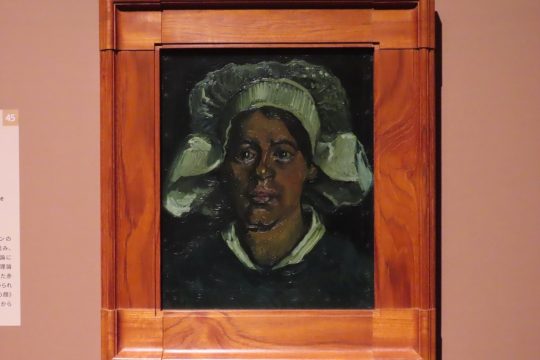
Vincent van Gogh 《Face of a Woman in a White Hat》 November 1884-May 1985 Kroller-Muller Museum Collection
I think that many people cite "vivid colors," "swells," and "extremely thick coating" as the characteristics of Van Gogh's work, but all of these characteristics have been exhibited since he moved his base from his native Netherlands to France. Born in the latter half of the year. This exhibition introduces Van Gogh's painting industry, whose style of painting has changed dramatically, in chronological order.
Van Gogh spent five years in the Netherlands since he began his career as a painter in 1880. In the early days, painters called "Hague School" who liked the lives of farmers and fishermen and the landscape of the countryside using dull colors such as gray and brown, and Jean-Francois Millet, who is known as a peasant painter. While being influenced, I hurried to master drawing and eventually made an oil painting.
Through the painting industry, I continued to have a keen interest in the cycle of harvesting and the transition of the four seasons, from sowing, which I thought was a symbol of nature, especially infinity and eternity. From the exhibition, we can see that they carefully picked up themes such as the appearance of workers working in rural areas while being closely related to nature, the facial expressions of their poverty, and sadness and grief.
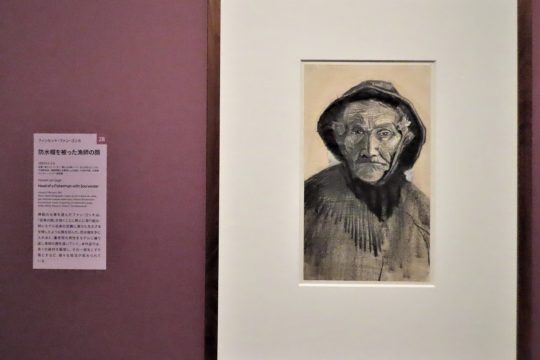
Vincent van Gogh << Face of a fisherman wearing a waterproof cap >> January 1883 Kroller-Muller Museum Collection He especially liked the face that reflected the hardships of the model himself.
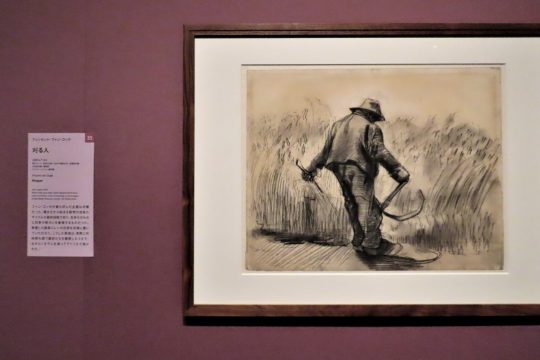
Vincent van Gogh << Mowing Man >> July-August 1885 Kroller-Muller Museum Collection Among the working farmers, the appearance of harvesting wheat is repeatedly studied.
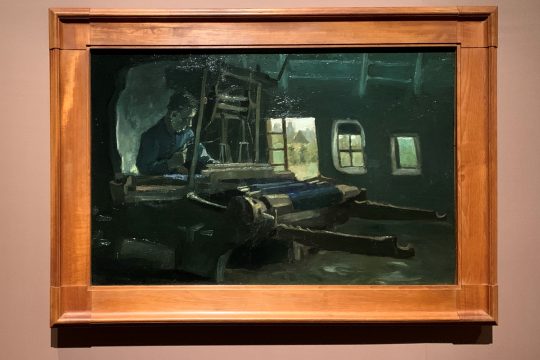
Vincent van Gogh << Looms and Weavers >> June-July 1884 Kroller-Muller Museum Collection It seems that he was keenly interested not only in farmers but also in weavers. The atmosphere of the weaver, which is said to be "dreamy and pensive", is beautifully expressed.
In 1886, Van Gogh headed to Paris, France, and was shocked by the Impressionists, Neo-Impressionists, and Japanese ukiyo-e prints he met there, and his style changed dramatically.
Subsequent works will be rich in color and the screen will become brighter. Notice that we have also begun to incorporate pointillism techniques with brush strokes that prevent color turbidity by arranging small touches without mixing paint.
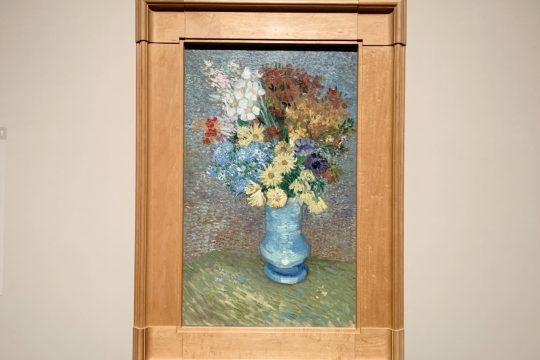
Vincent van Gogh "Flowers in a Blue Vase" Around June 1887 Kroller-Muller Museum Collection Brilliant colors unthinkable in the Dutch era. The vases and flowers are Impressionist, and the background is influenced by the Neo-Impressionist pointillism technique.
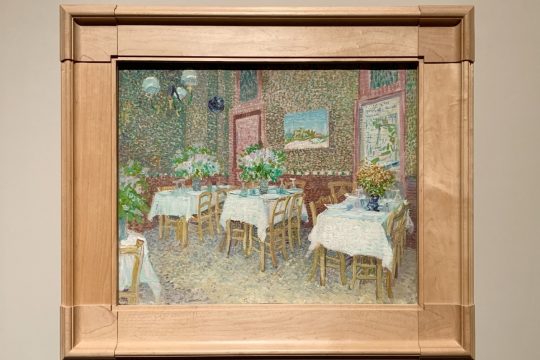
Vincent van Gogh "Inside the restaurant" Summer 1887 Collection of the Kroller-Muller Museum Although not rigorous, this is also a work in which a neo-impressionist pointillism technique reminiscent of Seurat is being attempted.
In Arles, southern France, where he moved from 1888, he was fascinated by the bright blue of the sky and yellow as the color of the blazing sun, and enthusiastically repeated experiments on color effects with the combination of complementary colors of blue and yellow. From this area, you can see the process of creating a "Van Gogh-like" expressionist style of painting that many people know, with a sculptural and thick brush stroke that imitates the shape of the object with the touch of a paintbrush.
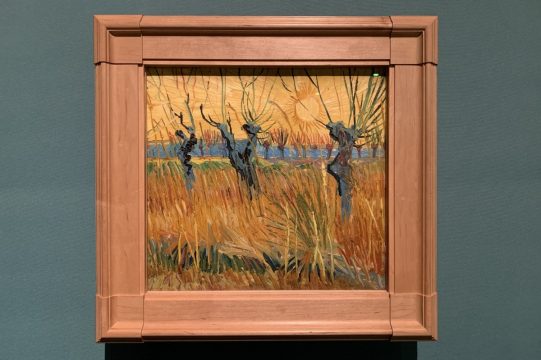
Vincent van Gogh 《Pruned Willow at Dusk》 March 1888 The blue of the willow in the Kroller-Muller Museum highlights the sunshine of Arles.
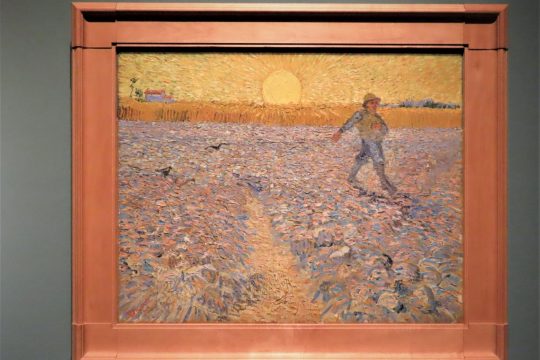
Vincent van Gogh "The Sower" June 17-28, 1888 Kroller-Muller Museum Collection A tribute to Millet's "The Sower" that he admired. We are challenging the contrast of intense complementary colors. Even with this, the brush strokes are thickly layered, and the unevenness makes the work more powerful.
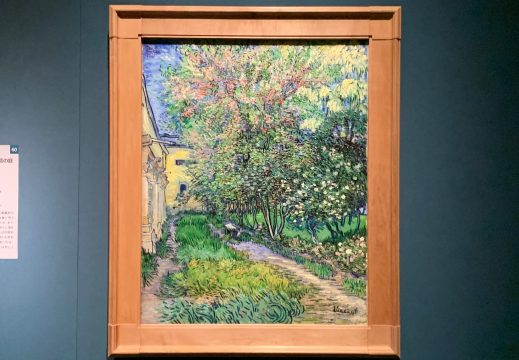
Vincent van Gogh 《Saint-Rémy Sanatorium Garden》 1889 Kroller-Muller Museum Collection
In 1889, while admitted to Saint-Remy's sanatorium due to illness, he worked on typical Provencal motifs such as the garden of the sanatorium and the surrounding countryside, as well as cypress and olive groves, and devised the expression of "swell". , Produced masterpieces such as "Country Road in Provence at Night" and the famous "Starry Night". After moving to Auvers-sur-Oise in northern France in 1890, he continued to produce one piece a day, inspired by the beautiful scenery of the village and its surroundings. It seems that he was also exploring the possibility of a new style of brush strokes.
Van Gogh has been constantly learning from new places and new encounters, and has spent his life holding the brush even if no one understands the work. From Helene's collection, I was able to witness his belief and passion, "I want to express something soothing like music in a painting."
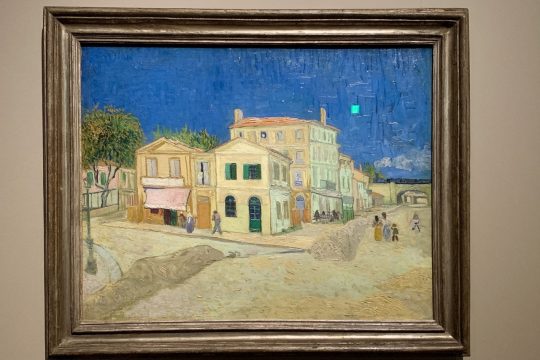
Vincent van Gogh "Yellow House (Street)" September 1888 Visited Japan for the first time in 16 years, like the "Country Road in Provence at Night" in the Van Gogh Museum (Vincent van Gogh Foundation).
In addition to the works in the Kroller-Muller Museum, this exhibition introduces another great museum in the Netherlands, including four fans from the Van Gogh Museum collection, such as "The Yellow House (Street)".・ Van Gogh's works are exhibited.
These works are permanently lent by the Vincent van Gogh Foundation, which was established by his wife Yo after the death of his younger brother Theo, who supported Van Gogh financially and mentally, to prevent the works from being dissipated. .. She was also one of the people who devoted her life to spreading Van Gogh's art to the world.
The exhibition "Van Gogh Exhibition : Resonating Souls Helene and Vincent" will be held until December 12, 2021 (Sun).
By all means at this exhibition, while thinking about the fact that many people today have made efforts to preserve and inherit the works of art in the past, we can evaluate and exchange opinions with each other. Immerse yourself in the charm of a rare collection.
"Van Gogh Exhibition : Resonating Souls Helene and Vincent" Outline
| Session | September 18th (Sat) -December 12th (Sun), 2021 |
| venue | Tokyo Metropolitan Art Museum Planning Exhibition Room |
| Opening hours | 9: 30-17: 30 (Enter until 30 minutes before closing) |
| closing day | Monday * However, the room will be open on November 8th (Monday), November 22nd (Monday), and November 29th (Monday). |
| Admission fee | General 2,000 yen, college / vocational school students 1,300 yen, 65 years old and over 1,200 yen * It is a reservation system with a designated date and time. * Free for high school students and younger. (Reservation with specified date and time is required) Click here for other details ⇒ https://gogh-2021.jp/ticket.html |
| Organizer | Tokyo Metropolitan Foundation for History and Culture Tokyo Metropolitan Museum of Art, Tokyo Shimbun, TBS |
| inquiry | 050-5541-8600 (Hello dial) |
| Exhibition official website | https://gogh-2021.jp |
<Past coverage articles>
Nogizaka girls resonate with Japanese art. [Tokyo National Museum Hyokeikan] "Spring, Summer, Autumn and Winter / Four Seasons Nogizaka46" (~ 11/28) Preview Report


